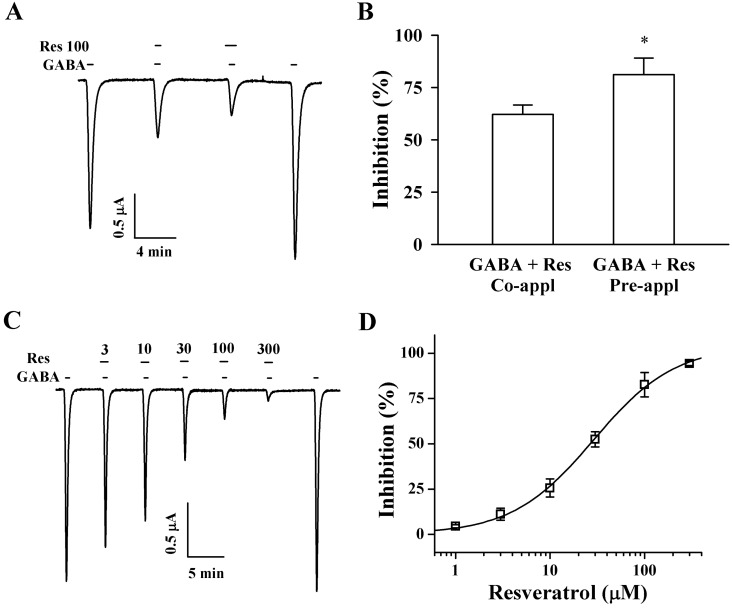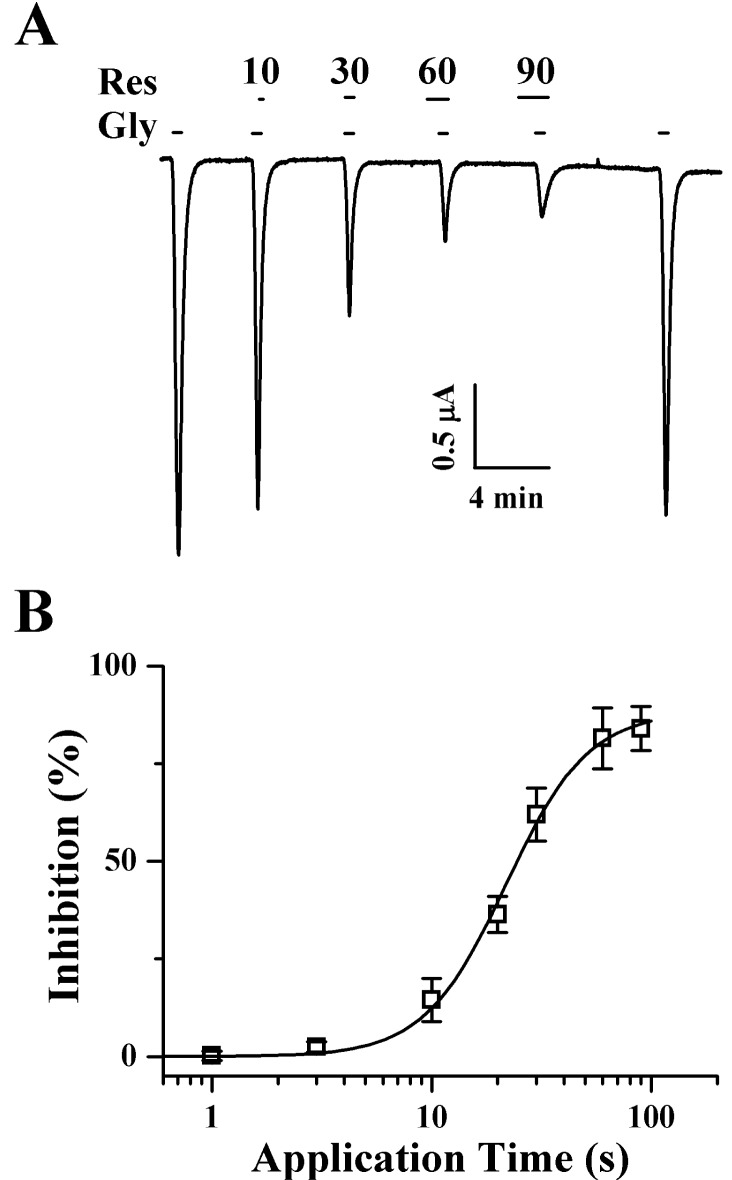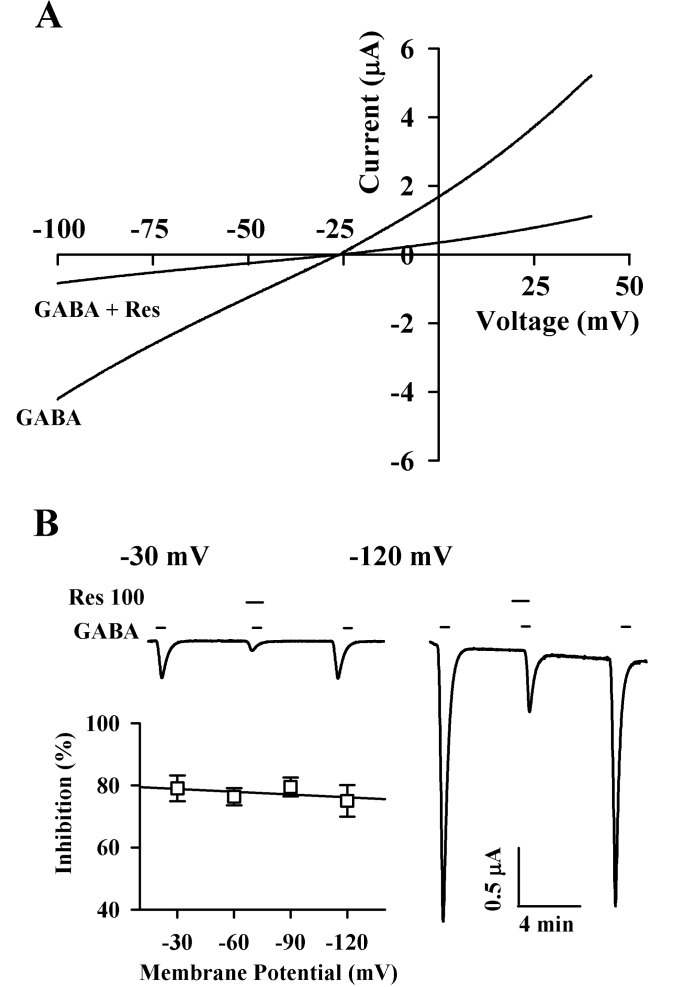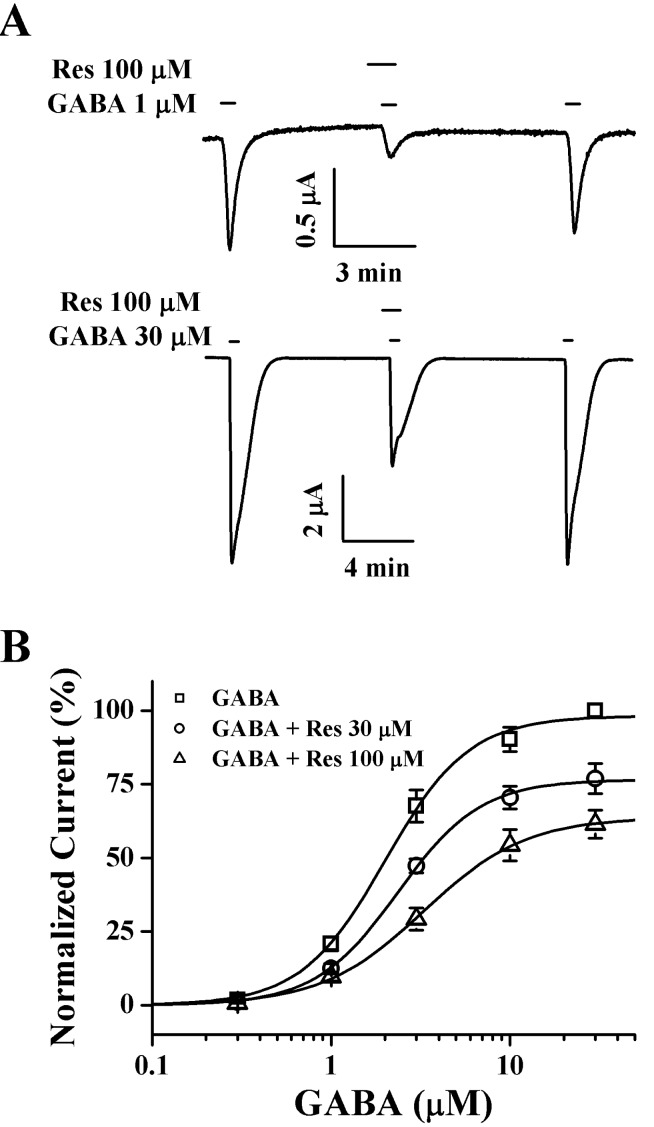INTRODUCTION
METHODS
Materials
Oocyte preparation
Oocyte recording
cRNA preparation of GABAC receptor ρ1 and microinjection
Data analysis
RESULTS
Effect of resveratrol on IGABA in oocytes that express homomeric GABAC receptors
 | Fig. 2Effect of Res on IGABA expression in oocytes that express GABAC receptors. (A) GABA (2 µM) was first applied and then GABA was co- or pre-applied with Res (100 µM). Thus, co- and pre-application of Res with GABA inhibited IGABA. The resting membrane potential of oocytes was approximately -35 mV, and oocytes were voltage clamped at a holding potential of -80 mV prior to drug application. Traces are representative of 6 separate oocytes from 3 frogs. (B) Pre-application of Res inhibited IGABA more potently than that inhibited by co-treatment. (C) IGABA in GABAC receptors expressing oocytes was elicited at -80 mV holding potential, with indicated time in the presence of 2 µM GABA and with the indicated pre-treatment concentration of Res that was applied before GABA application. (D) IGABA % inhibition induced by Res treatment was calculated using the average of peak that the inward current elicited by GABA treatment before Res application and of the peak inward current elicited by GABA treatment after pre-treatment of Res before GABA. The continuous line shows the curve fitted according to the equation. Each point represents the mean±S.E.M. (n=9~12 from 3 frogs). |
Concentration-dependent effect of resveratrol on IGABA in oocytes with GABAC receptor
 | Fig. 3Time-dependent effects of pre-application of Res on IGABA in oocytes that express GABAC receptors. (A) Res (100 µM)-mediated inhibition on IGABA is pre-application-time dependent. Traces represent 6 separate oocytes from 3 frog batches. IGABA in GABAC receptor-expressing oocytes was elicited at a holding potential of -80 mV for the indicated Res pre-application time prior to drug application. (B) Res-mediated inhibition of IGABA was almost saturated after 30 s of pre-application. The resting membrane potential of the oocytes was approximately -35 mV, and the oocytes were voltage-clamped at a holding potential of -80 mV. Each point represents the mean±S.E.M. (n=9~12/group). |
Current-voltage relationship and voltage-independent inhibition of IGABA in oocytes that express GABAC receptors mediated by resveratrol
 | Fig. 4Current-voltage relationship and voltage-independent inhibition by Res. (A) Current-voltage relationships of IGABA inhibition by Res in GABAC receptor-expressing oocytes. Representative current-voltage relationships were obtained using voltage ramps of -100 to +40 mV for 300 ms at a holding potential of -80 mV. Voltage steps were applied before and after application of 2 µM GABA in the absence or presence of 100 µM Res. (B) Voltage-independent inhibition of IGABA in the GABAC receptors by Res. Inset; the values were obtained from the receptors in the presence or absence of 100 µM Res at the indicated membrane holding potentials. |
Noncompetitive inhibition of GABAC receptors by resveratrol
 | Fig. 5Concentration-dependent effects of GABA on Res-mediated inhibition of IGABA. (A) The representative traces were obtained from the GABAC receptor-expressing oocytes. IGABA expression shown in the upper and lower panels were elicited at a holding potential of -80 mV by GABA at concentrations of 1 µM and 30 µM GABA respectively. (B) Concentration-response relationship of GABA with GABAC receptors treated with GABA (0.3~30 µM) alone or with GABA plus pre-application of 30 µM or 100 µM Res. The IGABA of oocytes expressing the GABAC receptors was measured using the indicated concentration of GABA in the absence (□) or presence of 30 µM (○) or 100 µM (▵) Res. Oocytes were exposed to GABA alone or to GABA with Res. Oocytes were voltage-clamped at a holding potential of -80 mV. Each point represents mean±S.E.M. (n=9~12/group). |




 PDF
PDF ePub
ePub Citation
Citation Print
Print



 XML Download
XML Download